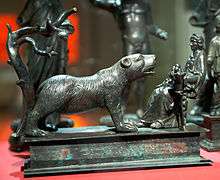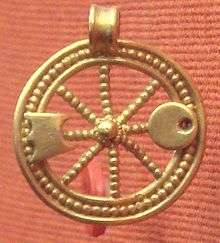Artio
Artio (Dea Artio in the Gallo-Roman religion) was a Celtic bear goddess. Evidence of her worship has notably been found at Bern. Her name is derived from the Gaulish word for "bear", artos.[1]
Representations and inscriptions

A bronze sculpture from the Muri statuette group, found near Bern in Switzerland, shows a large bear facing a woman seated in a chair, with a small tree behind the bear. The woman seems to hold fruit in her lap, perhaps feeding the bear.[2]. The sculpture has a large rectangular bronze base, which bears the inscription "Deae Artioni / Licinia Sabinilla" ("To the Goddess Artio" or "Artionis", "from Licinia Sabinilla"). If the name is Gaulish but the syntax is Latin, a dative Artioni would give an i-stem nominative *Artionis or an n-stem nominative *Artio. That would perhaps correspond to a Gaulish n-stem nominative *Artiu.
Other inscription to the goddess have been discovered in Daun (CIL 13, 4203), Weilerbach (CIL 13, 4113), Heddernheim (CIL 13, 7375 [4, p 125]), and Stockstadt (CIL 13, 11789).
Etymology
Her name is derived from the Gaulish word artos, bear (Delamarre 2003 p. 55-56), from Proto-Celtic *arto-, from Proto-Indo-European *h₂ŕ̥tḱos, bear. A Celtic word may also be the source for the name Arthur.
Popular culture
Artio is a playable character in the video game Smite. She comes from the Celtic pantheon and is a melee, magical guardian. She can freely transform between her human representation (druid stance) and her bear form (bear stance), both of which come with their own sets of abilities. Her kit mainly focuses on healing her and her allies and locking down enemies in her druid stance and then outputting large amounts of damage with her bear stance.
References
- Adrian Room, Placenames of the World: Origins and Meanings of the Names for 6,600 Countries, Cities, Territories, Natural Features, and Historic Sites, McFarland, 2006, p. 57.
- Deyts p. 48, Green pp. 217–218
- Corpus Inscriptionum Latinarum (CIL) vol XIII, Inscriptiones trium Galliarum et Germaniarum
- Delamarre, X. (2003). Dictionnaire de la Langue Gauloise (2nd ed.) Paris: Editions Errance. ISBN 2-87772-237-6
- Deyts, Simone (1992) Images des Dieux de la Gaule. Paris: Editions Errance. ISBN 2-87772-067-5.
- Green, Miranda (1992) Animals in Celtic Life and Myth. London: Routledge. ISBN 0-415-18588-2
- Wightman, E. M. (1970) Roman Trier and the Treveri London: Hart-Davis. ISBN 0-246-63980-6

